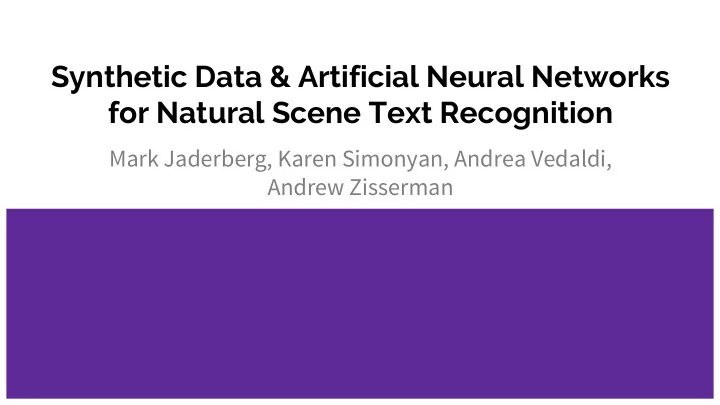

Synthetic Data & Artificial Neural Networks for Natural Scene Text Recognition Mark Jaderberg, Karen Simonyan, Andrea Vedaldi, Andrew Zisserman
OUTLINE Objective ● Challenges ● Synthetic Data Engine ● Models ● Experiments and Results ● Discussion and Questions ●
Objective To build a framework for Text Recognition in Natural Images Image Credits: Synthethic Data and Artificial Neural Networks for Natural Scene Text Recognition (Poster)
Challenges ● Inconsistent lighting, distortions, background noise, variable fonts, orientations etc.. ● Existing Scene Text datasets are very small and cover limited vocabulary.
Synthetic Data Engine Credits: Synthethic Data and Artificial Neural Networks for Natural Scene Text Recognition
Models Authors propose 3 Deep Learning Models: ● Dictionary Encoding ● Character Sequence Encoding ● Bag of NGrams encoding
Base Architecture ● 2 x 2 Max Pooling after 1st, 2nd and 3rd Convolutional Layer ● SGD for optimization ● Dropout for regularization Credits: Synthethic Data and Artificial Neural Networks for Natural Scene Text Recognition
Dictionary Encoding (DICT) [Constrained Language Model] Multiclass Classification Problem (One class per word w in Dictionary W ) Slide Credits: Synthethic Data and Artificial Neural Networks for Natural Scene Text Recognition (Poster)
Character Sequence Encoding (CHAR) CNN with multiple independent classifiers (one for each character) ● No language model but need to fix max length of the word. ● Suitable for unconstrained recognition Slide Credits: Synthethic Data and Artificial Neural Networks for Natural Scene Text Recognition (Poster)
BAG of N-Grams Encoding (NGRAM) Represent a word as bag of N-grams. Eg G(Spires) = { s, p, i, r, e, s, sp, pi, ir, re, es, spi, pir, ire, res } Slide Credits: Synthethic Data and Artificial Neural Networks for Natural Scene Text Recognition (Poster)
+2 Models ● Lack of overfitting on basic models suggests their under-capacity. ● Try larger models to investigate the effect of additional model capacity. ● Extra convolutional layer with 512 filters ● Extra 4096 unit fully connected layer at the end
Experiments and Results Image Credits: Synthethic Data and Artificial Neural Networks for Natural Scene Text Recognition (Poster)
Base Models vs +2 Models Model Trained Synth IC03-50 IC03 SVT-50 SVT IC13 Lexicon DICT IC03 FULL IC03 FULL 98.7 99.2 98.1 - - - DICT SVT FULL SVT FULL 98.7 - - 96.1 87.0 - DICT 50K 50K 93.6 99.1 92.1 93.5 78.5 92.0 DICT 90K 90K 90.3 98.4 90.0 93.7 70.0 86.3 DICT +2 90K 90K 95.2 98.7 93.1 95.4 80.7 90.8 CHAR 90K 71.0 94.2 77.0 87.8 56.4 68.8 CHAR +2 90K 86.2 96.7 86.2 92.6 68.0 79.5 NGRAM NN 90K 25.1 92.2 - 84.5 - - NGRAM +2 NN 90K 27.9 94.2 - 86.6 - -
Quality of Synthetic Data Model Trained Synth IC03-50 IC03 SVT-50 SVT IC13 Lexicon DICT IC03 FULL IC03 FULL 98.7 99.2 98.1 - - - DICT SVT FULL SVT FULL 98.7 - - 96.1 87.0 - DICT 50K 50K 93.6 99.1 92.1 93.5 78.5 92.0 DICT 90K 90K 90.3 98.4 90.0 93.7 70.0 86.3 DICT +2 90K 90K 95.2 98.7 93.1 95.4 80.7 90.8 CHAR 90K 71.0 94.2 77.0 87.8 56.4 68.8 CHAR +2 90K 86.2 96.7 86.2 92.6 68.0 79.5 NGRAM NN 90K 25.1 92.2 - 84.5 - - NGRAM +2 NN 90K 27.9 94.2 - 86.6 - -
Effect of Dictionary Size Model Trained Synth IC03-50 IC03 SVT-50 SVT IC13 Lexicon DICT IC03 FULL IC03 FULL 98.7 99.2 98.1 - - - DICT SVT FULL SVT FULL 98.7 - - 96.1 87.0 - DICT 50K 50K 93.6 99.1 92.1 93.5 78.5 92.0 DICT 90K 90K 90.3 98.4 90.0 93.7 70.0 86.3 DICT +2 90K 90K 95.2 98.7 93.1 95.4 80.7 90.8 CHAR 90K 71.0 94.2 77.0 87.8 56.4 68.8 CHAR +2 90K 86.2 96.7 86.2 92.6 68.0 79.5 NGRAM NN 90K 25.1 92.2 - 84.5 - - NGRAM +2 NN 90K 27.9 94.2 - 86.6 - -
Slide Credits: Synthethic Data and Artificial Neural Networks for Natural Scene Text Recognition (Poster)
Examples Image Credits: Synthethic Data and Artificial Neural Networks for Natural Scene Text Recognition (Poster)
Applications ● Image Retrieval ● Self Driving Cars
Discussion and Questions ● How fair is it to assume knowledge of target lexicon ? ● Has synthetic data been used in any other domains ? ● Can we use RNN models for predicting words character level classification ? ● Are there better ways of mapping Ngrams to words ? ● How are collisions handled in Ngrams model ? ● How diverse does the text synthesis output need to be ?
References [1] Synthethic Data and Artificial Neural Networks for Natural Scene Text Recognition [2] Synthethic Data and Artificial Neural Networks for Natural Scene Text Recognition (Poster)
Thank You :)
Recommend
More recommend